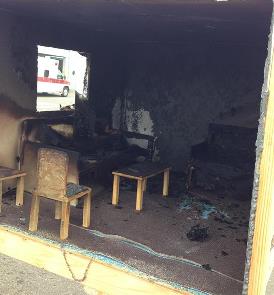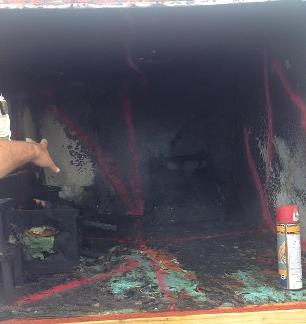
Mockup 1 was extinguished just after flashover. There was only slight floor charring, and wall calcination exists only at the point of ignition.
It was a dreary morning on Treasure Island on Thursday, August 14th, 2014, as a group of curious public defenders, detectives, and prosecutors came together for arson investigator Paul Bieber’s showcase event: a live burn of two furnished mockups, one third the size of a typical 12’ by 12’ household room. A former paramedic and firefighter with over 15 years of experience in fire investigation, Bieber is the director of the Monterey-based Arson Research Project (http://thearsonproject.org/), an independent criminal justice research project that works to expose the causes and consequences of faulty fire science. He has been involved in several exonerations nationwide, including NCIP’s own client, George Souliotes.
The purpose of the burn was to shine light on some of the historically mistaken assumptions drawn by fire investigators and detectives when examining burn sites. “The most impactful of these assumptions have been interpreting charring on the floor to imply the usage of liquid accelerants, and calcination (or whitish discoloring) on multiple walls to imply multiple points of ignition,” Bieber said. “Both of these interpretations often lead investigators to identify arson as the cause of a fire, and both, are misguided.” He explained that new research has shown that both floor charring and wall calcination can be the results of the far more common phenomenon of ‘flashover,’ or the point in a fire at which everything within the room combusts.

Mockup 2 was extinguished two minutes after flashover. Floors were charred completely, and calcination existed on multiple walls.
To put the theory of flashover into practice, Bieber and his team sent the scaled mockups aflame with a single point of ignition and without using any liquid accelerants. While Bieber extinguished the first mock-up just after flashover, he allowed the second to burn for an additional two minutes.
The difference between the two was stark. Whereas the burn patterns of the first mockup painted a clear picture of where the fire started and exhibited only a slight amount of floor charring, the second mockup presented entirely charred floors, and calcination on multiple walls. Under the lens of fire science past, the burn evidence of the second mockup screamed arson. In actuality, however, the only difference between the two was the length of burn time after flashover was reached.
Mistaking the doings of flashover burning for arson is a lesson that Bieber shares with investigators and prosecutors nationwide. He hopes that burns such as this will encourage prosecutors and investigators to take a more nuanced approach when examining burn sites, and, eventually, play a role in combatting wrongful convictions.
by Ramsey Fisher, NCIP student intern